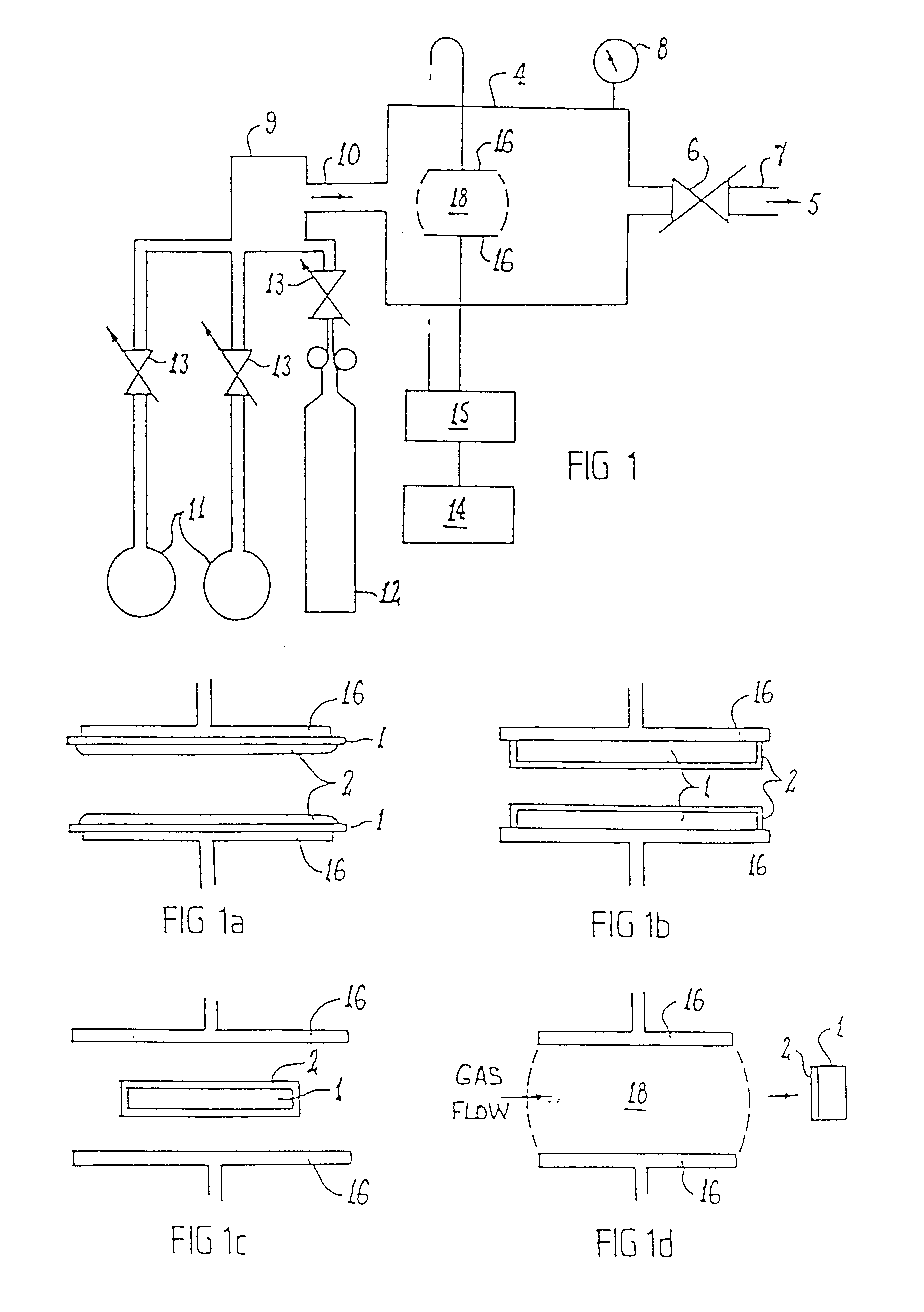Surface modification of polymers
a surface modification and polymer technology, applied in the field of surface modification of polymers, can solve the problems of poor adhesion, fluoropolymer is not amenable to the usual surface modification techniques, and is extremely difficult to bond with adhesives, so as to improve the adhesion properties of ptfe, improve bonding strength, and improve bonding. good
- Summary
- Abstract
- Description
- Claims
- Application Information
AI Technical Summary
Benefits of technology
Problems solved by technology
Method used
Image
Examples
example 1
Effect of Plasma Gas
In this example the surface of PTFE coupons were modified by various plasmas in the plasma reactor illustrated in FIG. 1. After plasma surface modification, the coupons were bonded with cyanoacrylate adhesive (LOCTITE 406). The treatment conditions and bond strengths are summarised in Table 1.
The surface modifications were:
i) no treatment;
ii) ammonia plasma treatment operated at 175 kHz, 0.5 torr and 25 watts and at various duration;
iii) plasma polymerisation of n-butylamine performed at 175 kHz, 0.3 torr and at various energy levels and treatment durations;
iv) plasma polymerisation of 1,3 diaminopropane (DAP) done at 175 kHz, 0.3 torr, 20 watts and various treatment durations.
As can be seen from specimen 1 of Table 1, untreated PTFE has very poor bonding. Ammonia plasma treatment improves the bonding strength but lap shear strength at optimal conditions ranges around 3 to 4 MPa. These values have been documented in the paper by Liston et al referred to above and...
example 2
Effect of Power Application Mode
This example shows the bonding properties of PTFE modified by plasma polymerisation of alkylamine using continuous or intermittent power mode, PTFE coupons were surface modified by these plasmas then bonded with cyanoacrylate adhesive (LOCTITE 406). Lap shear test was performed according to the method described in Example 1. Results obtained on specimens tested are summarised in Table 2.
The surface surface modifications were:
i) plasma polymerisation of n-butylamine under continuous mode at 175 kHz, 0.3 torr and different energy levels and treatment durations;
ii) plasma polymerisation of n-butylamine under intermittent plasma mode at 175 kHz, 0.3 torr and different energy levels and treatment durations. For this plasma mode, plasma generator was turned on at operating pressure and then turned off at wanted treatment duration. The plasma chamber was pumped down to less than 0.05 torr then adjusted to the operating pressure. Another cycle of plasma polym...
example 3
This example illustrates the application of intermittent plasma polymerisation of alkylamine on other type of polymers. High density polyethylene (HDPE) and polypropylene (PP) were subjected to surface modifications with n-butylamine plasma polymer obtained under continuous or Intermittent plasma mode and bonded with cyanoacrylate adhesive (LOCTITE 406). The lap shear strength of specimens tested is summarised in Table 3.
The surface modifications were:
i) no treatment
ii) plasma polymerisation of n-butylamine under continuous mode at 175 kHz, 0.3 torr and dissipated energy of 25 watts;
iii) plasma polymerisation of n-butylamine under intermittent plasma mode at 175 kHz, 0.3 torr and dissipated energy of 25 watts.
It can be seen from Table 3, although significant improvement of bonding strength is achieved by surface modification of continuous plasma polymerisation of n-butylamine, the adhesion performance is better when the plasma is operated intermittently at similar conditions. Failur...
PUM
| Property | Measurement | Unit |
|---|---|---|
| pressures | aaaaa | aaaaa |
| temperature | aaaaa | aaaaa |
| pressures | aaaaa | aaaaa |
Abstract
Description
Claims
Application Information
 Login to View More
Login to View More - R&D
- Intellectual Property
- Life Sciences
- Materials
- Tech Scout
- Unparalleled Data Quality
- Higher Quality Content
- 60% Fewer Hallucinations
Browse by: Latest US Patents, China's latest patents, Technical Efficacy Thesaurus, Application Domain, Technology Topic, Popular Technical Reports.
© 2025 PatSnap. All rights reserved.Legal|Privacy policy|Modern Slavery Act Transparency Statement|Sitemap|About US| Contact US: help@patsnap.com


